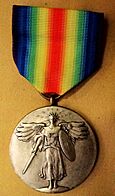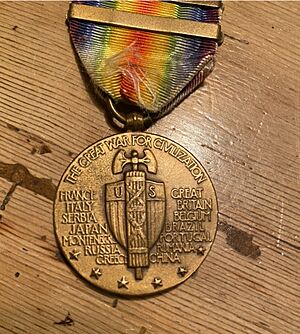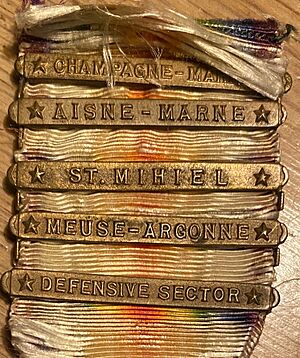World War I Victory Medal (United States) facts for kids
Quick facts for kids World War I Victory Medal |
|
|---|---|

|
|
| Country | |
| Type | Service medal |
| Eligibility | Military personnel only |
| Awarded for | "service between April 6, 1917, and November 11, 1918, or with either of the following expeditions:
|
| Status | Obsolete |
| Description | A medal of bronze 36 millimeters in diameter. On the obverse is a winged Victory standing full length and full face. On the reverse is the inscription The Great War for Civilization and the coat of arms for the United States surmounted by a fasces, and on either side the names of the Allied and Associated Nations. The medal is suspended by a ring from a silk moire ribbon 1 3/8 inches in length and 36 millimeters in width, composed of two rainbows placed in juxtaposition and having the red in the middle, with a white thread along each edge. |
| Motto | The Great War for Civilization |
| Statistics | |
| Established | 1919 |
| Precedence | |
| Next (higher) | Mexican Border Service Medal |
| Next (lower) | Army of Occupation of Germany Medal |
Service ribbon and campaign streamer |
|
The World War I Victory Medal was a special award given to military members in the United States. It was designed by an artist named James Earle Fraser. Before World War II, people just called it the "Victory Medal."
After World War I ended, countries that fought together decided to create a common medal. Each country would design its own "Victory Medal" for its soldiers. But all these medals would share some things in common. For example, they would all show a winged figure of Victory on the front and have the same rainbow-colored ribbon.
This medal was supposed to be created by a special law from Congress. However, that law never passed. So, the Army and Navy decided to create the medal through their own rules. The Army announced it in April 1919, and the Navy followed in June of the same year.
Contents
Who Received the Medal?
The Victory Medal was given to military members who served between April 6, 1917, and November 11, 1918. This period covers most of World War I. It was also given to those who served in two special groups after the war:
- The American Expeditionary Forces in European Russia between November 12, 1918, and August 5, 1919.
- The American Expeditionary Forces Siberia between November 23, 1918, and April 1, 1920.
What Does the Medal Look Like?
The medal is made of bronze.
- The front shows a winged Victory holding a shield and a sword. Victory is like a goddess of triumph.
- The back says "The Great War For Civilization" at the top. At the bottom, there are six stars. In the middle, there's a column of seven staffs (like poles) wrapped in a cord. This staff is on top of a shield with "U" on the left and "S" on the right, standing for United States.
On the left side of the staff, the names of some Allied countries are listed: France, Italy, Serbia, Japan, Montenegro, Russia, and Greece. On the right side, you can see: Great Britain, Belgium, Brazil, Portugal, Rumania (an older spelling for Romania), and China.
Special Attachments for the Medal
The World War I Victory Medal could have different small attachments, called "devices," to show what a soldier or sailor did during the war. These devices showed if someone fought in a specific battle or served in a certain area.
If someone in the Navy was praised by the Secretary of the Navy for their excellent work during World War I, they could get a small silver star. This star was worn on the medal's ribbon.
Army Battle Clasps
Soldiers who fought in major ground battles received special "battle clasps." These were small metal bars with the battle's name on them. They were worn on the medal's ribbon. Here are some of the main battles:
| Army Battle Clasps | ||||||
|---|---|---|---|---|---|---|
| Major Ground Conflict | Start Date | End Date | ||||
| Aisne | May 27, 1918 | June 5, 1918 | ||||
| Aisne-Marne | July 18, 1918 | August 6, 1918 | ||||
| Cambrai | May 12, 1917 | December 4, 1917 | ||||
| Champagne-Marne | July 15, 1918 | July 18, 1918 | ||||
| Lys | April 9, 1918 | April 27, 1918 | ||||
| Meuse-Argonne | September 26, 1918 | November 11, 1918 | ||||
| Montdidier-Noyon | June 9, 1918 | June 13, 1918 | ||||
| Oise-Aisne | August 18, 1918 | November 11, 1918 | ||||
| St. Mihiel | September 12, 1918 | September 16, 1918 | ||||
| Somme-Defensive | March 21, 1918 | April 6, 1918 | ||||
| Somme-Offensive | August 8, 1918 | November 11, 1918 | ||||
| Vittorio-Veneto | October 24, 1918 | November 4, 1918 | ||||
| Ypres-Lys | August 19, 1918 | November 11, 1918 | ||||
If a soldier was involved in general defense, but not a specific battle listed above, they would get a "Defensive Sector" clasp. This clasp was also given for battles that didn't have their own special clasp.
General John J. Pershing, who led the American forces, received all 14 battle clasps. His medal is now in the National Museum of American History.
The Navy also had battle clasps for sailors who helped in Army operations. These clasps had the same names as the Army ones, but sometimes the dates were a little different.
| Navy Battle Clasps | ||||||
|---|---|---|---|---|---|---|
| Major Ground Conflict | Start Date | End Date | ||||
| Aisne | June 1, 1918 | June 5, 1918 | ||||
| Aisne-Marne | July 18, 1918 | July 20, 1918 | ||||
| Meuse-Argonne | September 29, 1918 | October 10, 1918 | ||||
| Meuse-Argonne | October 25, 1918 | November 11, 1918 | ||||
| St. Mihiel | September 12, 1918 | September 16, 1918 | ||||
| Ypres-Lys (Service in support of the Northern Bombing Group) | ||||||
Navy personnel could also get the "Defensive Sector" clasp if they were in naval combat but didn't qualify for a specific battle clasp.
For sailors who performed specific duties at sea, the Navy issued "operational clasps." These clasps were also worn on the medal and named the type of duty performed. They were rectangular bronze bars.
| Navy Operational Clasps | ||||||
|---|---|---|---|---|---|---|
| Operation | Start Date | End Date | ||||
| Armed Guard: Merchant personnel (freighters, tankers, and troop ship) | April 6, 1917 | November 11, 1918 | ||||
| Asiatic: Service on any vessel that visited a Siberian port | April 6, 1917 | November 11, 1918 | ||||
| Asiatic: Port visit must have exceeded ten days in length | November 12, 1918 | March 30, 1920 | ||||
| Atlantic Fleet: Service in the Atlantic Fleet | May 25, 1918 | November 11, 1918 | ||||
| Aviation: Service involving flying over the Atlantic Ocean | May 25, 1918 | November 11, 1918 | ||||
| Destroyer: Service on destroyers on the Atlantic Ocean | May 25, 1918 | November 11, 1918 | ||||
| Escort: Personnel regularly attached to escort vessels on the North Atlantic | April 6, 1917 | November 11, 1918 | ||||
| Grand Fleet: Personnel assigned to any ship of the "United States Grand Fleet" | December 9, 1917 | November 11, 1918 | ||||
| Mine Laying: Service in mine laying sea duty | May 26, 1918 | November 11, 1918 | ||||
| Mine Sweeping: Service in mine sweeping sea duty | April 6, 1917 | November 11, 1918 | ||||
| Mobile Base: Service on tenders and repair vessels | April 6, 1917 | November 11, 1918 | ||||
| Naval Battery: Service as a member of a naval battery detachment | July 10, 1918 | November 11, 1918 | ||||
| Overseas: Service on shore in allied or enemy countries of Europe | April 6, 1917 | November 11, 1918 | ||||
| Patrol: War patrol service on the Atlantic Ocean | May 25, 1918 | November 11, 1918 | ||||
| Salvage: Salvage duty performed on the seas | April 6, 1917 | November 11, 1918 | ||||
| Submarine: Submarine duty performed on the Atlantic Ocean | May 25,1918 | November 11, 1918 | ||||
| Submarine Chaser: Anti-submarine duty performed on the Atlantic Ocean | May 18, 1918 | November 11, 1918 | ||||
| Transport: Personnel regularly attached to a transport or cargo vessel | April 6, 1917 | November 11, 1918 | ||||
| White Sea: Service on any vessel which visited a Russian port or war patrols in the White Sea not less than ten days | November 12, 1918 | July 31, 1919 | ||||
Unlike the Army, the Navy only allowed one clasp of any type on the ribbon. If a Marine or medical corps member served in France but didn't get a battle clasp, they would receive a bronze Maltese cross on their ribbon.
Army Service Clasps
For soldiers who performed non-combat duties during World War I, there were "service clasps." These clasps were inscribed with the name of the country or region where they served.
| Army Service Clasps | ||||||
|---|---|---|---|---|---|---|
| Country or Region | Start Date | End Date | ||||
| England | April 6, 1917 | November 11, 1918 | ||||
| France | April 6, 1917 | November 11, 1918 | ||||
| Italy | April 6, 1917 | November 11, 1918 | ||||
| Russia | November 12, 1918 | August 5, 1919 | ||||
| Siberia | November 23, 1918 | April 1, 1920 | ||||
The Navy also issued similar service clasps for service in different regions:
| Navy Service Clasps | ||||||
|---|---|---|---|---|---|---|
| Region | Start Date | End Date | ||||
| England | April 6, 1917 | November 11, 1918 | ||||
| France | April 6, 1917 | November 11, 1918 | ||||
| Italy | April 6, 1917 | November 11, 1918 | ||||
| Russia | November 12, 1918 | July 31, 1919 | ||||
| Siberia | November 12, 1918 | March 30, 1920 | ||||
| West Indies | April 6, 1917 | November 11, 1918 | ||||
Campaign Stars
Since the battle and service clasps were only for the full-sized medal, small bronze "service stars" were created. These stars were worn on the medal's ribbon when it was displayed on a military uniform. This was a common way to show participation in campaigns and battles.
Maltese Cross
Medals given to U.S. Marines had a Maltese cross attached to the ribbon.
The Lapel Button
There was also a World War I Victory Button (or just "Victory Button"). This was a small pin designed for veterans to wear on their regular clothes. It was a five-pointed star on a wreath with the letters "U.S." in the middle.
- If a person was wounded in action, their button was silver.
- For everyone else, it was bronze.
The sculptor Adolph Alexander Weinman designed this button. This button is also a key part of the American Legion emblem, a group for American veterans.
How Medals Were Given Out
The World War I Victory Medals were sent to servicemen after the war ended. They weren't given out in person. For example, boxes with the medals for U.S. Army veterans were mailed from Philadelphia, Pennsylvania, starting in April 1921.
Each medal came in a light brown outer box with an address label. Inside, a white box showed which clasps the serviceman was supposed to receive. The medal itself was wrapped in tissue paper.
To get their medal, veterans had to fill out a special form. The Army began sending out these medals on June 21, 1920, and the Navy started in August 1920.
Victory Medals Around the World
The United States wasn't the only country to create a World War I Victory Medal. Many other allied nations also made their own versions. This idea came from French Maréchal Ferdinand Foch, who was the supreme commander of the Allied Forces.
Each of these bronze Victory Medals had the same size (36 millimeters) and the same rainbow-colored ribbon. However, each country's medal had its own unique design, usually showing a winged victory figure.
| Country | Designer | Manufacturer | Number issued |
| Belgium | Paul Du Bois (1859–1938) | — | 300,000–350,000 |
| Brazil | Jorge Soubre (1890–1934) |
|
approximately 2,500 |
| Cuba | Charles Charles |
|
6,000–7,000 |
| Czechoslovakia | Otakar Španiel (1881–1955) |
|
approximately 89,500 |
| France | Pierre-Alexandre Morlon (1878–1951) |
|
approximately 2,000,000 |
| France | Charles Charles |
|
— |
| France |
|
— | — |
| United Kingdom | William McMillan (1887–1977) |
|
6,334,522 plus |
| Greece | Henry-Eugène Nocq (1868–1944) |
|
approximately 200,000 |
| Italy | Gaetano Orsolini (1884–1954) |
|
approximately 2,000,000 |
| Japan | Shoukichi Hata |
|
193,300 |
| Poland | .... Vlaitov |
|
— |
| Portugal | João Da Silva (1880–1960) |
|
approximately 100,000 |
| Romania | .... Kristesko | — | approximately 300,000 |
| Siam (Thailand) | Itthithepsan Kritakara (1890–1935) | — | approximately 1,500 |
| South Africa | William McMillan (1887–1977) |
|
approximately 75,000 |
| United States | James Earle Fraser (1876–1953) |
|
approximately 2,500,000 |
See also





